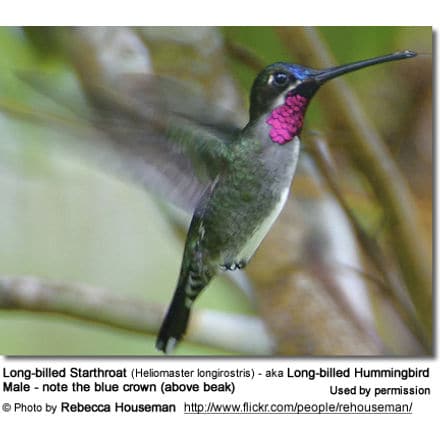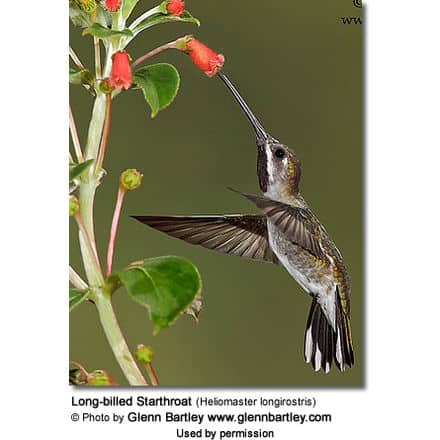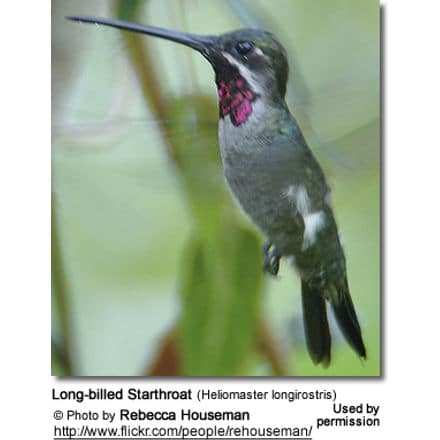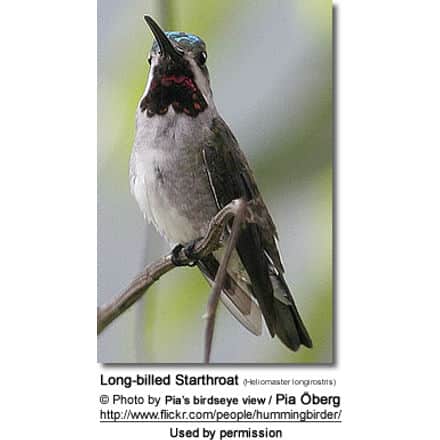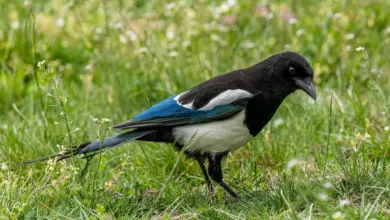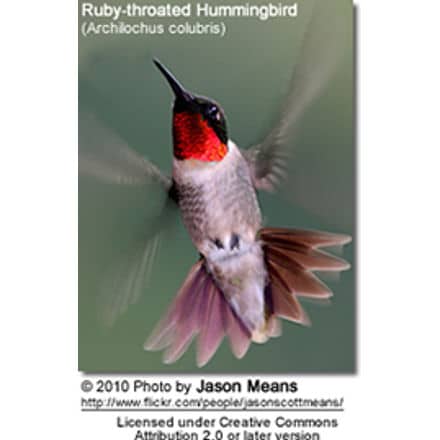Long-billed Starthroats – Hummingbirds
Hummingbird Information
The Long-billed Starthroats (Heliomaster longirostris) – also commonly referred to as the Long-billed Hummingbird – is found in Central America and northern South America, where it is an uncommon but widespread hummingbird species.
Alternate (Global) Names
Spanish: Ermitaño Colilargo, Ermitaño Colilargo Norteño … French: Ermite à longue queue … German: Westlicher Langschwanz-Schattenkolibri … Czech: kolib?ík západní … Danish: Langhalet Eremit … Finnish: pohjanerakkokolibri … Norwegian: Veststjerteremitt … Polish: pustelnik dlugodzioby, pustelnik d?ugodzioby …Slovak: slnecnícek dlhozobý … Swedish: Långstjärtad eremit
Distribution / Habitat
The Long-billed Starthroats are found from southern Mexico to Panama, from Colombia south and east to Bolivia, and central and north-east Brazil, as well as occurring on the Caribbean island Trinidad. It appears to be a local or seasonal migrant.
They appear to avoid the shady forest interior, typically remaining along forest edges and woodland clearings, but may also occur in open habitats such as cerrado. They will also visit gardens. They typically remain up the canopy.
Subspecies and Distribution:
-
-
- Heliomaster longirostris longirostris – Nominate Race (Audebert and Vieillot, 1801)
- Range: Eastern and Southwestern Costa Rica, Panama, and Colombia south to eastern Bolivia and central and northeast Brazil; Trinidad
- Heliomaster longirostris pallidiceps (Gould, 1861)
- Range: South Mexico to Nicaragua
Heliomaster longirostris albicrissa (Gould, 1871)
- Range: Western Ecuador and Northwestern Peru
- Heliomaster longirostris longirostris – Nominate Race (Audebert and Vieillot, 1801)
-
Description:
The Long-billed Starthroats average 10.2 cm (~4 inches) in length and weighs around 6.8 g (~0.2 oz). The black beak is straight and about 3.5 cm (~1.4 in) long.
The male is bronze-green on the back. He has a blue crown, a small white spot behind the eyes, and an iridescence throat that is sometimes described as reddish or dark metallic purple. The plumage below is grey, shading to white on the flanks and mid-abdomen. The mostly black tail is square and tipped with white.
The female looks similar, but she has a green crown and a purple-edged dusky grey throat.
Nesting / Breeding
Hummingbirds are solitary in all aspects of life other than breeding, and the male’s only involvement in the reproductive process is the actual mating with the female. They neither live nor migrate in flocks, and there is no pair bond for this species. Males court females by flying in a U-shaped pattern in front of them. He will separate from the female immediately after copulation. One male may mate with several females. In all likelihood, the female will also mate with several males. The males do not participate in choosing the nest location, building the nest, or raising the chicks.
The female Long-billed Starthroats are responsible for building the cup-shaped nest out of plant fibers woven together and green moss on the outside for camouflage in a protected location in a shrub, bush, or tree. She lines the nest with soft plant fibers, animal hair, and feathers down, and strengthens the structure with spider webbing and other sticky material, giving it an elastic quality to allow it to stretch to double its size as the chicks grow and need more room. The nest is typically found on a low, thin horizontal branch.
The average clutch consists of two white eggs, which she incubates alone, while the male defends his territory and the flowers he feeds on. The young are born blind, immobile, and without any down.
The female alone protects and feeds the chicks with regurgitated food (mostly partially digested insects since nectar is an insufficient source of protein for the growing chicks). The female pushes the food down the chicks’ throats with her long bill directly into their stomachs.
As is the case with other hummingbird species, the chicks are brooded only the first week or two and are left alone even on cooler nights after about 12 days – probably due to the small nest size. The chicks leave the nest when they are about 20 days old.
Diet / Feeding
The Rainbow Starfrontlets primarily feed on nectar taken from a variety of brightly colored, scented small flowers of trees, herbs, shrubs, and epiphytes. They favor flowers with the highest sugar content (often red-colored and tubular-shaped) and seek out, and aggressively protect, those areas containing flowers with high-energy nectar. They use their long, extendible, straw-like tongues to retrieve the nectar while hovering with their tails cocked upward as they are licking at the nectar up to 13 times per second. Sometimes they may be seen hanging on the flower while feeding.
Many native and cultivated plants on whose flowers these birds feed heavily rely on them for pollination. The mostly tubular-shaped flowers exclude most bees and butterflies from feeding on them and, subsequently, from pollinating the plants.
They may also visit local hummingbird feeders for some sugar water, or drink out of bird baths or water fountains where they will either hover and sip water as it runs over the edge; or they will perch on the edge and drink – like all the other birds; however, they only remain still for a short moment.
They also take some small spiders and insects – important sources of protein particularly needed during the breeding season to ensure the proper development of their young. The Rainbow Starfrontlets are often observed catching insects in midair (“hawking”).
Metabolism and Survival and Flight Adaptions – Amazing Facts
Call / Vocalizations:
Its song, while feeding, is described as a light weet.
Species Research by Sibylle Johnson
Please Note: The articles or images on this page are the sole property of the authors or photographers. Please contact them directly with respect to any copyright or licensing questions. Thank you.


